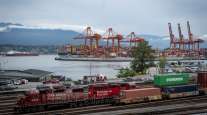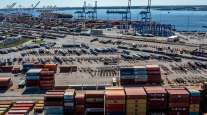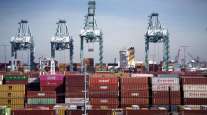Senior Reporter
Ports Report Strong September as Retailers Restock

[Ensure you have all the info you need in these unprecedented times. Subscribe now.]
Just months after cargo volumes plunged amid the COVID-19 pandemic, the nation’s ports are staging a comeback as falling product inventory levels at warehouses, stores and medical facilities are being quickly replenished.
Simultaneously, the economy shows signs of recovery, and the holiday shopping season is set to begin.
The nation’s busiest port, the Port of Los Angeles, set a record in September, processing 13.3% more 20-foot-equivalent units, totaling 883,625 containers compared with 779,902 last year. Officials also said the third quarter was the best in the port’s 113-year history as 2,701,847 TEUs were processed.
The Port of Long Beach accomplished a pair of records in September by achieving its busiest month ever and its most active quarter in its 109-year history.
Read more: https://t.co/YsMjMGkgsT pic.twitter.com/jJdHdOk3SL — Port of Long Beach (@portoflongbeach) October 21, 2020
They said imports were key to the recovery as the economies of China and other Asian nations recover from the coronavirus.
“Despite unresolved questions about our nation’s health, economy and export strength, imports have improved significantly after a difficult spring,” Port of Los Angeles Executive Director Gene Seroka said.
The nearby Port of Long Beach also had a solid September, moving 795,580 cargo TEUs, and that broke the record for a month set just two months ago. September’s figure is up 12.5% compared to 2019’s 706,955 TEUs.
Large retail stores are reopening, merchants are stocking up for the winter holidays, and the increased use of e-commerce appears to be an enduring trend.
Mario Cordero, Port of Long Beach
Long Beach processed 2,274,271 TEUs during the third quarter, a 14.1% increase from the third quarter of 2019. The port enjoyed its busiest quarter on record, topping the previous mark set in the third quarter of 2017 by 160,000 containers.
“Large retail stores are reopening, merchants are stocking up for the winter holidays, and the increased use of e-commerce appears to be an enduring trend picked up by consumers during the recent stay-at-home orders,” port Executive Director Mario Cordero said. “Still, we must move ahead with caution during the remaining months of 2020.”
The Port of Oakland reported a 9.3% year-over-year increase in September, processing 225,809 TEUs compared with 206,539 in 2019, making it the best September in its history.
Officials say the retailers are hedging against another COVID-19 wave this fall and winter, and retailers appear to be building up their stocks as they continue to see the spread of more factory closures and lockdowns.
“Several months into this pandemic, we are now seeing positive signs by these cargo volume totals,” Port of Oakland Maritime Director Bryan Brandes said. “As retailers make sure shelves are well-stocked, we’re waiting to see if consumers begin shopping early this holiday season.”
In Seattle-Tacoma, the Northwest Seaport Alliance reported September was its best month of 2020, processing 308,682 TEUs. Still, that was down compared with 347,278 in 2019.
While the numbers are below 2019’s pace, officials say they are optimistic about the rest of the year.
“This is very encouraging news, and we’re hopeful for a stronger rebound as we close out the year and look forward to 2021,” CEO John Wolfe said.
IHS Markit Transportation Economist Paul Bingham told Transport Topics because of the COVID-19 pandemic and the spring-summer economic slowdown in Asia, U.S. inventories are at their lowest levels in years and retailers believe it’s time to restock.
“This was a ratcheting up forward in terms of household consumption via e-commerce that we’re not going to see go away, but it’s not going to continue to grow at the pace it has the last couple of months,” Bingham said. “People are not spending at restaurants, hotels and leisure travel; they’re sitting at their keyboards or smartphones ordering things to be delivered.”
On the East Coast, the Port of Virginia had a record September, processing 256,439 TEUs, up 6.2% from 2019’s 241,416.
“The rebound continues, and we are seeing indicators that imports could remain strong into 2021 as inventory restocking continues and the retail season gets underway,” Virginia Port Authority CEO John Reinhart said.
The Georgia Port Authority said its Savannah facility recorded an 11.4% uptick, moving 412,138 TEUs, compared with 369,999 last year.
In the first quarter of Fiscal Year 2021 (July-September), the Port of Savannah handled 1.2 million twenty-foot equivalent container units, an increase of 1.6 percent or 19,663 TEUs. Join us for the 2020 virtual State of the Port: https://t.co/lL20Lmtoej. #SAVSOP #georgiaports pic.twitter.com/5DzHKxiKg4 — Georgia Ports (@GaPorts) October 22, 2020
The August and September numbers, when both months topped 400,000 TEUs, are a comeback from March, April, May and June when the complex ran TEU numbers that consistently were in the 337,000 range.
South Carolina’s Port of Charleston reported its September TEU numbers were flat compared with 2019, processing 0.1% more containers —195,101 compared with 194,948 in the 2019 period.
“September volumes outperformed expectations as we see an uptick in cargo flowing through our marine terminals and inland ports,” South Carolina Ports Authority CEO Jim Newsome said.
Port Houston reported a 1.1% year-over-year increase, handling 254,405 TEUs compared with 251,524 in the prior-year period. The improvement occurred even as the Gulf of Mexico and Houston shipping channel dealt with a series of tropical weather disturbances, which reduced traffic and closed the channel for three days.
“We’ve had a solid import peak season with retailers bringing in product from overseas in strong numbers,” CEO Roger Guenther said. “September volumes were positive.”
The Port of New York and New Jersey, the busiest facility on the East Coast, typically has yet to report volume numbers for September.
Want more news? Listen to today's daily briefing:
Subscribe: Apple Podcasts | Spotify | Amazon Alexa | Google Assistant | More





